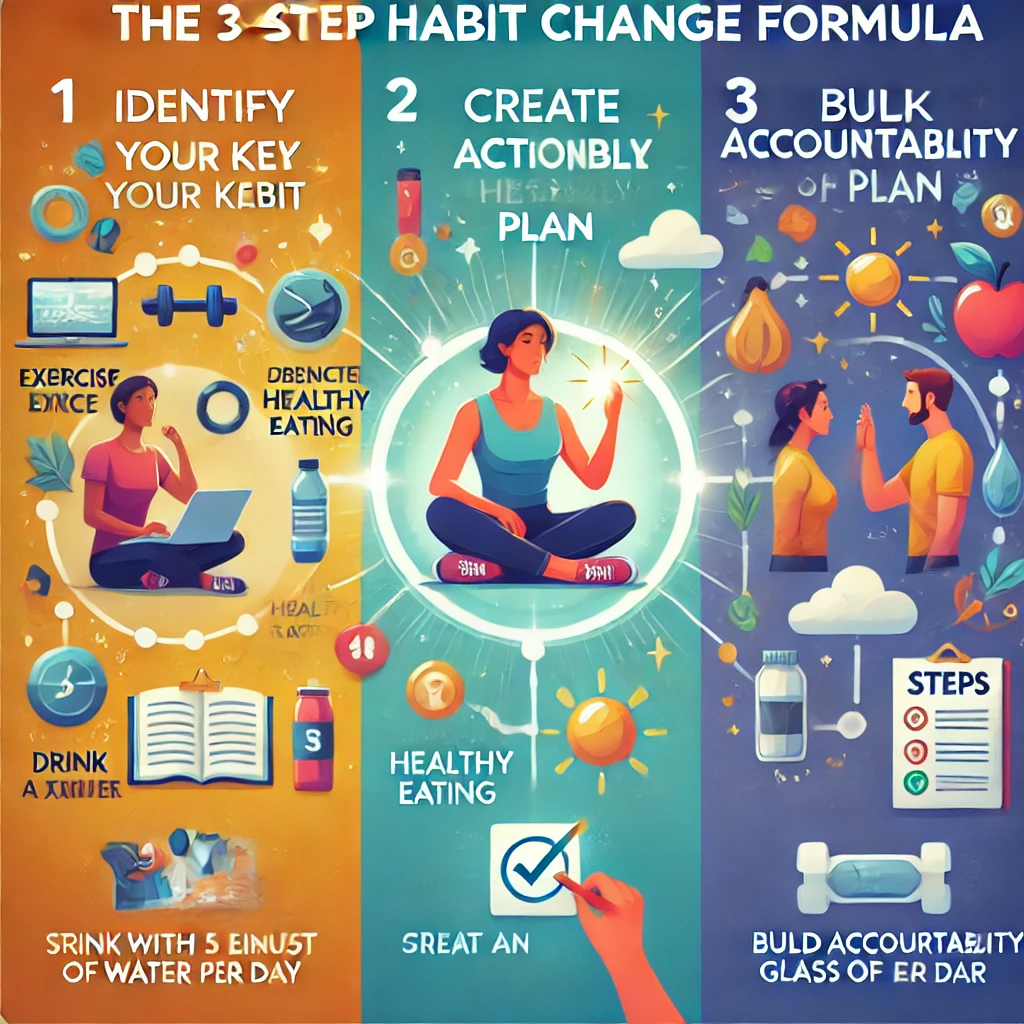Habits shape our lives in powerful ways. The small actions we take daily accumulate over time, influencing our health, happiness, and success. While many people attempt to overhaul their lives by changing multiple habits at once, the key to lasting transformation is focusing on one impactful habit at a time. This strategic approach prevents overwhelm and maximizes results. In this guide, we’ll explore The 3-Step Habit Change Formula, which includes how to identify your key habit, create an actionable plan, and build accountability to ensure long-term success.
Step 1: Identify Your Key Habit
The first step in creating meaningful change is selecting a single habit that will have the biggest positive impact on your life. Instead of spreading your efforts thin by tackling multiple changes at once, focus on one high-leverage habit that can create a ripple effect in other areas.
How to Choose the Right Habit
To identify your key habit, ask yourself:
- What is one habit that, if improved, would significantly enhance my overall well-being?
- Which habit influences multiple areas of my life (e.g., health, productivity, relationships)?
- What is one change I can commit to daily without feeling overwhelmed?
For example, if you struggle with low energy, improving your sleep quality might be the most impactful habit to focus on. Better sleep can lead to increased productivity, improved mood, and better physical health. Alternatively, if stress is a major issue, a daily mindfulness or journaling practice might be your keystone habit.
The Power of Keystone Habits
Some habits are more powerful than others because they create a domino effect—positively influencing multiple aspects of life. These are known as keystone habits. Examples include:
- Regular Exercise – Improves physical health, boosts mood, and enhances mental clarity.
- Consistent Sleep Schedule – Increases energy, improves cognitive function, and strengthens immune health.
- Daily Journaling or Meditation – Reduces stress, enhances focus, and improves self-awareness.
- Healthy Eating Habits – Leads to better energy levels, improved digestion, and overall wellness.
Real-Life Example
Sarah, a busy professional, found herself constantly tired and unproductive. Instead of trying to change multiple lifestyle factors at once, she focused on one habit: drinking more water. This small change led to better hydration, which improved her energy levels and helped her make healthier food choices. Over time, this one habit triggered a series of positive changes in her daily routine.
Step 2: Create an Actionable Plan
Once you’ve identified your key habit, the next step is to break it down into small, manageable steps. Too often, people set ambitious goals and give up when they feel overwhelmed. A sustainable approach involves gradual progress and setting yourself up for success.
Break It Down Into Small Steps
Instead of attempting drastic changes, start small and build momentum. Here’s how:
- Start with a micro-habit – Reduce the habit to its simplest form. If you want to start exercising, begin with just five minutes a day instead of committing to an hour-long workout.
- Set a trigger – Tie your new habit to an existing routine. For example, if you want to practice gratitude, do it right after brushing your teeth.
- Use habit stacking – Attach your new habit to something you already do consistently. If you want to read more, commit to reading a single page before checking your phone in the morning.
The Science of Habit Formation
According to research, habits follow a loop consisting of three components:
- Cue (Trigger): A reminder that prompts the habit (e.g., setting out gym clothes the night before).
- Routine: The habit itself (e.g., going for a five-minute walk).
- Reward: A positive reinforcement that strengthens the habit (e.g., feeling more energized after exercise).
Understanding this cycle helps in designing an actionable plan that sets you up for success.
Real-Life Example
John wanted to become more active but found hour-long workouts daunting. Instead of forcing himself into an unsustainable routine, he started with a five-minute walk every morning. As this habit became second nature, he gradually increased his time and intensity. Within a few months, John was consistently exercising 30 minutes a day without feeling overwhelmed.
Step 3: Build Accountability
Accountability is a game-changer when it comes to habit formation. Studies show that people who share their goals with others or seek external support are significantly more likely to succeed.
Ways to Stay Accountable
- Find a Support System – Having an accountability partner, coach, or support group can keep you motivated. Share your goals with someone who will check in and offer encouragement.
- Track Your Progress – Use a habit tracker, journal, or app to monitor your consistency. Visually seeing your progress reinforces your commitment.
- Reward Yourself – Celebrate small wins along the way. Acknowledging your progress keeps motivation high and makes the journey enjoyable.
Why Accountability Works
Accountability creates external motivation, reducing the chances of giving up. When you know someone is tracking your progress, you’re more likely to follow through.
Real-Life Example
Emily wanted to improve her eating habits but struggled with consistency. She partnered with a friend who had similar goals. They checked in daily, shared meal ideas, and celebrated their progress together. This accountability system made it easier for Emily to stay on track and develop long-lasting habits.
How Each Step Works Together
Let’s say you want to develop a reading habit. Here’s how you would apply The 3-Step Habit Change Formula:
- Identify Your Key Habit – Commit to reading daily to enhance knowledge and reduce screen time before bed.
- Create an Actionable Plan – Start with five minutes a day, tie it to an existing habit (e.g., right before bedtime), and place your book on your pillow as a reminder.
- Build Accountability – Use a reading app to track progress, join a book club, or find a reading partner to discuss books with.
By focusing on one habit at a time, breaking it into small steps, and staying accountable, you create sustainable change that positively impacts multiple areas of your life. Small, consistent actions lead to significant transformation over time.
Final Thoughts
Transforming your life doesn’t require drastic overhauls. The key lies in following The 3-Step Habit Change Formula: choosing one impactful habit, implementing small, manageable steps, and using accountability to stay on track. Whether it’s drinking more water, exercising, journaling, or improving sleep, focusing on one key habit at a time will lead to meaningful and lasting results.
Challenge: Take Action Today
Now that you understand The 3-Step Habit Change Formula, take action today:
- Write down one key habit you want to develop.
- Identify a small step you can take immediately.
- Find an accountability partner or tracking method.
Start today with a single step, and watch as it creates a powerful ripple effect in your life.
Always remember, You are capable of amazing things and You are worthy of your wildest dreams!
Until next time, friend!
XOXO,
Valerie
Your Doula & Transformation Coach 🌿






